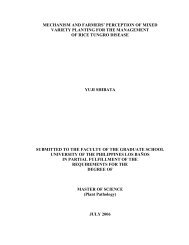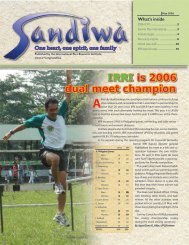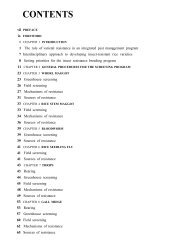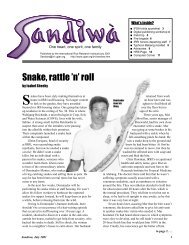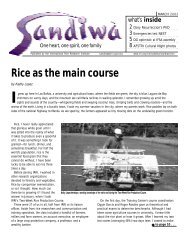Untitled - International Rice Research Institute
Untitled - International Rice Research Institute
Untitled - International Rice Research Institute
Create successful ePaper yourself
Turn your PDF publications into a flip-book with our unique Google optimized e-Paper software.
Seedborne fungi causing foliage diseases in rice<br />
Alternaria padwickii (Ganguly) Ellis<br />
syn. Trichoconis padwickii Ganguly<br />
Trichoconiella padwickii (Ganguly) Jain<br />
Disease caused: stackburn<br />
a. Symptoms<br />
On leaves—large oval or circular spots with a<br />
pale brown center and distinct dark brown margin.<br />
Color of center eventually becomes white and<br />
bears minute black dots.<br />
On grains—pale brown to whitish spots with black<br />
dots at the center and dark brown border.<br />
Roots and coleoptile of germinating seedlings—<br />
dark brown to black spots that eventually coalesce.<br />
Small, discrete, and black bodies are<br />
formed on the surface of the darkened area as<br />
decay proceeds.<br />
b. Occurrence/distribution<br />
Stackburn disease is widespread in most of the<br />
rice-growing countries worldwide (Fig. 4).<br />
c. Disease history<br />
The disease was first reported in the U.S. It resembles<br />
black rust of wheat on rice leaves, but<br />
only sclerotia and mycelium were observed.<br />
Later the fungus was observed in and on rice<br />
seeds.<br />
d. Importance in crop production<br />
Stackburn leaf spot disease is not considered to<br />
be of economic importance. However, seed infection<br />
results in grain discoloration, which may<br />
reduce germination and lower grain quality. The<br />
disease potential of stackburn is very low and the<br />
yield loss caused by A. padwickii in literature<br />
may be overestimated. The effect of infected<br />
seed on seed germination is not yet properly assessed.<br />
Detection on seed<br />
a. Incubation period on blotter<br />
A. padwickii is easily observed on seeds using the<br />
blotter method 5 d after seeding on moistened<br />
blotter and incubated under NUV at 21 °C. The<br />
detection frequency is about 67.1% on seeds<br />
coming from different regions (Fig. 5a,b).<br />
b. Habit character<br />
Seed infected with A. padwickii after incubation<br />
shows abundant aerial mycelia, hairy to cottony,<br />
profusely branched, grayish or hyaline when<br />
Fig. 4. Occurence of stackburn (Ou 1985, Agarwal and Mathur 1988, EPPO 1997).<br />
14



